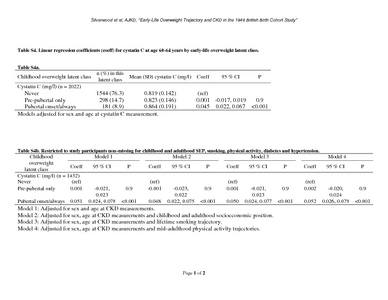Silverwood, RJ; Pierce, M; Hardy, R; Thomas, C; Ferro, C; Savage, C; Sattar, N; Kuh, D; Nitsch, D; National Survey of Health and Development Scientific and Data Co
(2013)
Early-Life Overweight Trajectory and CKD in the 1946 British Birth Cohort Study.
AMERICAN JOURNAL OF KIDNEY DISEASES, 62 (2).
276 - 284 (9).
ISSN 0272-6386
https://doi.org/10.1053/j.ajkd.2013.03.032
SGUL Authors: Thomas, Claudia
![[img]](https://openaccess.sgul.ac.uk/102146/1.hassmallThumbnailVersion/mmc4.pdf)  Preview |
|
["document_typename_application/pdf; charset=binary" not defined]
Published Version
Download (77kB)
| Preview
|
Abstract
Few studies have examined the impact of childhood obesity on later kidney disease, and consequently, our understanding is very limited.
Study Design
Longitudinal population-based cohort.
Setting & Participants
The Medical Research Council National Survey of Health and Development, a socially stratified sample of 5,362 singletons born in 1 week in March 1946 in England, Scotland, and Wales, of which 4,340 were analyzed.
Predictor
Early-life overweight latent classes (never, prepubertal only, pubertal onset, or always), derived from repeated measurements of body mass index between ages 2 and 20 years.
Outcomes & Measurements
The primary outcome was chronic kidney disease (CKD), defined as creatinine- or cystatin C–based estimated glomerular filtration rate (eGFRcr and eGFRcys, respectively) <60 mL/min/1.73 m2 or urine albumin-creatinine ratio (UACR) ≥3.5 mg/mmol measured at age 60-64 years. Associations were explored through regression analysis, with adjustment for socioeconomic position, smoking, physical activity level, diabetes, hypertension, and overweight at ages 36 and 53 years.
Results
2.3% of study participants had eGFRcr <60 mL/min/1.73 m2, 1.7% had eGFRcys <60 mL/min/1.73 m2, and 2.9% had UACR ≥3.5 mg/mmol. Relative to being in the never-overweight latent class, being in the pubertal-onset– or always-overweight latent classes was associated with eGFRcys-defined CKD (OR, 2.04; 95% CI, 1.09-3.82). Associations with CKD defined by eGFRcr (OR, 1.27; 95% CI, 0.71-2.29) and UACR (OR, 1.33; 95% CI, 0.70-2.54) were less marked, but in the same direction. Adjustment for lifestyle and health factors had little impact on effect estimates.
| Item Type: |
Article
|
| Additional Information: |
PubMed ID: 23714172 |
| Keywords: |
Childhood obesity, chronic kidney disease, estimated glomerular filtration rate, Science & Technology, Life Sciences & Biomedicine, Urology & Nephrology, Childhood obesity, chronic kidney disease, estimated glomerular filtration rate, GLOMERULAR-FILTRATION-RATE, LATENT CLASS ANALYSIS, OF-THE-LITERATURE, BODY-MASS INDEX, BLOOD-PRESSURE, MULTIPLE IMPUTATION, CHILDHOOD OVERWEIGHT, KIDNEY-DISEASE, RENAL-DISEASE, ALL-CAUSE |
| SGUL Research Institute / Research Centre: |
Academic Structure > Population Health Research Institute (INPH) |
| Journal or Publication Title: |
AMERICAN JOURNAL OF KIDNEY DISEASES |
| ISSN: |
0272-6386 |
| Dates: |
| Date | Event |
|---|
| 1 August 2013 | Published |
|
| PubMed ID: |
23714172 |
| Web of Science ID: |
23714172 |
 |
Download EPMC Full text (HTML)
|
 |
Go to PubMed abstract |
| URI: |
https://openaccess.sgul.ac.uk/id/eprint/102146 |
| Publisher's version: |
https://doi.org/10.1053/j.ajkd.2013.03.032 |
Statistics
Item downloaded times since 25 Oct 2013.
Actions (login required)
 |
Edit Item |



